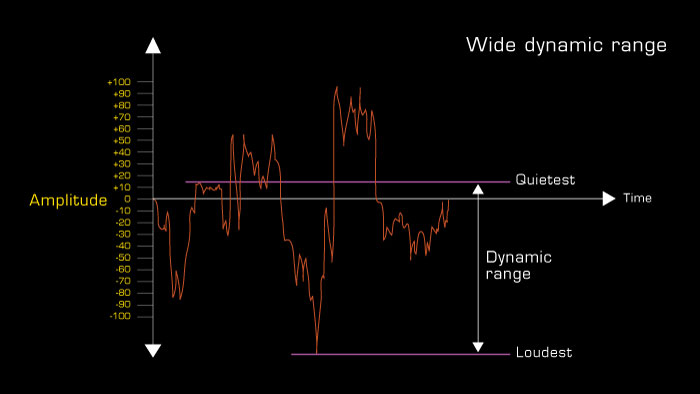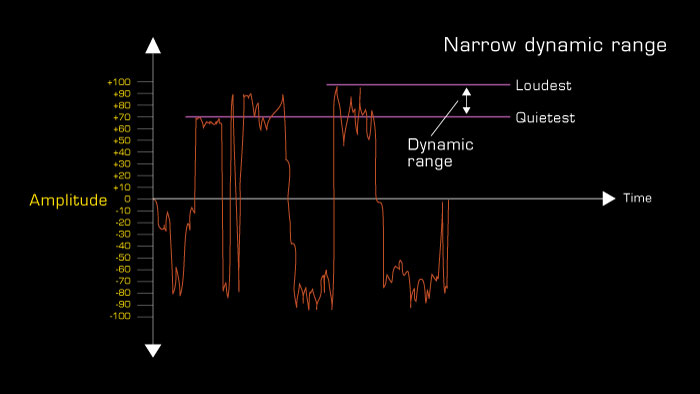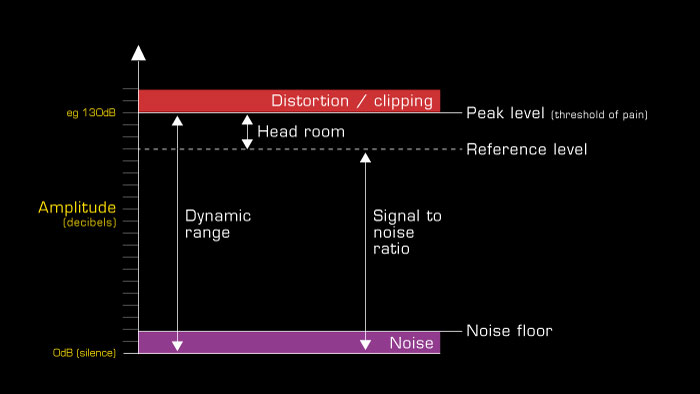The term "dynamic range" refers to ...
- the difference between the loudest and quietest parts of a soundwave, or the range of volumes.
2. the difference between the quietest and loudest sound a musical instrument can make
3. the ratio between the noise floor (beneath which a sound cannot be heard) and distortion (the point at which the electronics have inadequate (electrical) "power" to represent the volume of the soundwave) in an audio technology, such as a microphone or loudspeaker. It is the range of signals, between the quietest and loudest, that a given piece of equipment can accommodate. All audio equipment has a measurable dynamic range.
Now, click to watch our video at our sister site (or read on) ..
Wide and narrow dynamic range
If the difference between the loudest and quietest is large, it is said to be wide. If it is small it is said to be narrow


Signal to noise ratio
This is the ratio between the signal/soundwave level and the level of the noise inherent in the system. All audio technologies (especially analogue) produce some measurable noise (hiss) even when a signal is not present. In electrical circuits this is partly caused by the "jiggling" of electrons, which are never at rest. It is therefore desirable that the electronics in the equipment can accommodate as loud a signal as possible so that this noise is kept quiet in comparison.
Because noise can never be entirely eliminated, a system with a wider dynamic range will have a better signal to noise ratio. In other words, if the electronics are of a better specification, and can therefore accommodate much louder peak signals, then the noise floor will be quieter in comparison.
Some examples
- The dynamic range of a musical performance can be as wide as 120dB.
- Analogue tape (without noise reduction) has a dynamic range of about 60dB.
- FM radio has a maximum range of around 50dB.
- 16-bit digital audio (eg CD) has a maximum dynamic range of 96dB.
- 24-bit digital audio has a theoretical maximum dynamic range of 144dB, but the limitations of electronic design restrict this to an achievable real world maximum of 124dB.
- For every increase resolution of 1 bit, the dynamic range of a digital system increases by approx 6dB.
Maximising dynamic range
We can see that not only is equipment with wide dynamic range desirable, but that we should also seek to maximise the use of it by passing signals through it at as high an amplitude as possible. There is little point in having a good system if you pass signals through it at a low level.
The ideal amplitude will be 3dB below the peak level. Beyond the peak level clipping (distortion) will occur.
The worse case is when the soundwave is below the noise floor and therefore in-audible.
Distortion (clipping)
In a digital system clipping is unacceptable and produces unpleasant sound. Any signal exceeding the maximum (which is determined by the bit-depth) will be rounded to the largest possible digital value (eg 1111111111111111).
However, in an analogue system, as the signal exceeds the peak level the distortion may add desirable "colour" or "warmth" to the signal before becoming unpleasant. This is particularly true of valve (vacuum tube) electronics, particularly compressors, amplifiers and microphones, and analogue recording tape. With analogue tape, "warmth" becomes apparent around and just beyond the point where "saturation" takes place. Saturation is the point where the magnetic flux is at its maximum and beyond which there is no way to represent louder signals. As the signal exceeds saturation, there is a gradual onset of harmonic distortion. This is sometimes called "tape compression".
Setting the best signal to noise ratio
Most equipment manufactures quote the signal to noise ratio as the ratio between the noise (hiss) and the reference level (0dB) of the equipment. A user will achieve the best signal to noise ratio when the signal is as loud as possible without distorting.
For a source signal with predictable amplitude (such as a synthesiser or drum machine), this is simply a case of turning up the signal until clipping occurs and then turning it back down a bit.
For an unpredictable source, such as a singer, an automatic volume control (such as a compressor or limiter) may be needed to prevent clipping, or an engineer may monitor and manually "ride" the level with a fader.
Setting up a mixer input channel

